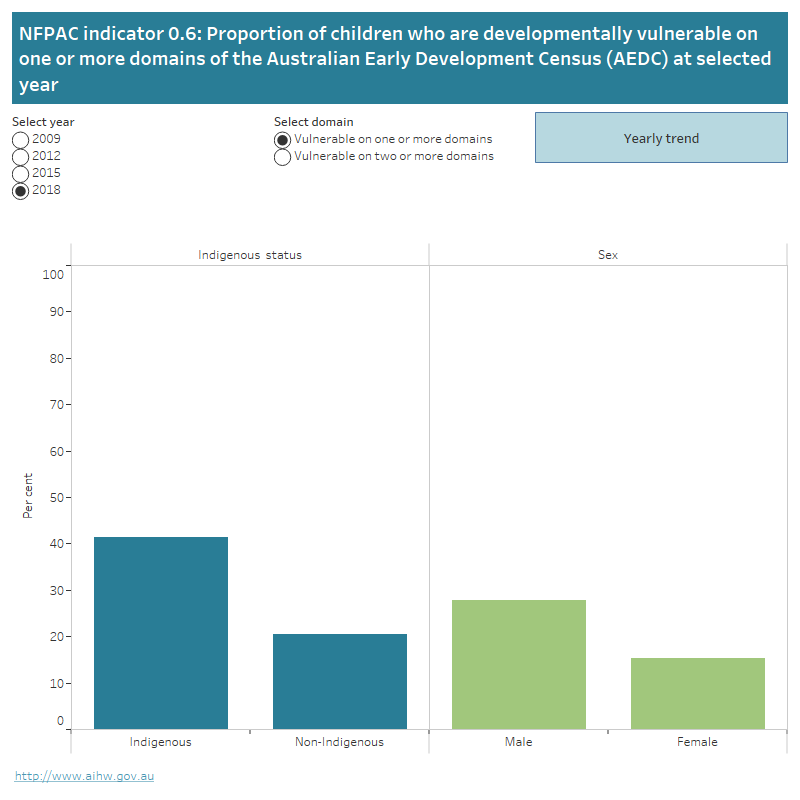0.6 Early childhood development
Children's early development has a profound impact on their future health, development, learning and wellbeing.
The Australian Early Development Census (AEDC) is a measure of children's development, based on the scores from a teacher-completed checklist in their first year of formal schooling (the preparatory year prior to Year 1). It is measured across the following five domains:
- physical health and wellbeing
- social competence
- emotional maturity
- language and cognitive skills
- communications skills and general knowledge.
Trend data: For all indicator displays, the yearly trend is limited to indicators with 3 or more years (including the current year) of comparable time series data. To see the trend click on “Yearly Trend” button on the display. Where 3 or more years of comparable data including the most recent year is not available, a “No time series data” message is shown on the display.
The first figure is a bar chart showing the proportion of children who are developmentally vulnerable on one or more domains of the Australian Early Development Census (AEDC), by Indigenous status and sex. Data can be presented by select years (2009, 2012, 2015 and 2018) and by domain (vulnerable on one or more domains or vulnerable on two or more domains).
The second figure is a line graph showing the proportion of children who are developmentally vulnerable on one or more domains of the Australian Early Development Census (AEDC) in 2009, 2012, 2015 and 2018. Data can be selected by Indigenous status, sex and domain (vulnerable on one or more domains or vulnerable on two or more domains).

Source: AIHW analysis of Australian Early Development Census (AEDC) data
See the supplementary data tables for further information and footnotes about these data.
Indicator technical specifications
The information below provides technical specifications for the summary indicator data presented in the quick reference guide.
| Definition | Data source | |
|---|---|---|
| Numerator | Number of children developmentally vulnerable on one or more domains of the AEDC | Australian Early Development Census (AEDC) |
| Denominator | Number of children with valid scores on one or more domains of the AEDC | Australian Early Development Census (AEDC) |
Explanatory notes
The AEDC is based on the scores from a teacher-completed checklist in the children's first year of full-time schooling - the preparatory year prior to Year 1 (this may be known as kindergarten, prep, pre-primary, reception or transition across jurisdictions).
There are five AEDC developmental domains: physical health and wellbeing; social competence; emotional maturity; language and cognitive skills (school-based); and communication skills and general knowledge.
Results on the AEDC domains group children into the following categories:
- developmentally vulnerable (below the 10th percentile)
- developmentally at-risk (between the 10th and 25th percentile)
- on track (between the 25th and the 50th percentile, and above the 50th percentile).
Results also describe children as developmentally vulnerable on one or more domains, and on two or more domains. These children are considered to be at particularly high risk developmentally.
Home-schooled children are not included in the AEDC as teachers collect these data. However, distance education is included.
In 2014, the Australian Early Development Index (AEDI) was renamed the AEDC.


